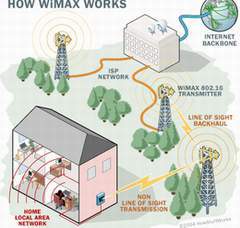 After much debate regarding the strengths of WiMAX technology and 3G, many experts now assert that these two technologies are not mutually exclusive. They believe that we can see benefits from combining both technologies.
After much debate regarding the strengths of WiMAX technology and 3G, many experts now assert that these two technologies are not mutually exclusive. They believe that we can see benefits from combining both technologies.
As the WiMAX standard IEEE 802.16e is still in the process of being certified, technology developers and telecommunications service providers have been tirelessly working to bring the potential of wireless broadband technology to life. However, in the rapid race to deploy systems, the question arises: how will WiMAX coexist with other mobile technologies? The true potential of WiMAX lies in its ability to transmit data, voice, and images seamlessly. It is poised for inevitable growth and success in the coming years.
The fundamental difference between WiMAX and 3G is that while 3G technology struggles with branded services and applications, WiMAX can support 3G, enabling it to overcome these challenges.
According to Forward Concept’s forecasts, WiMAX device sales are expected to rise from $72 million in 2005 to over $2 billion by 2009. In the WiMAX race, the smartest players must recognize whether they are telecommunications service providers, manufacturers, or equipment producers. In this case, WiMAX does not compete with 3G; rather, 3G is the key to the emergence of next-generation networks.
Developers, suppliers, and telecommunications service providers all realize that to achieve long-term business effectiveness, they need to innovate useful combined technologies at reasonable prices to retain loyal customers and attract new ones while increasing average revenue per device. WiMAX can help them overcome this challenge through cost reduction strategies, increased coverage, and opening up numerous business opportunities in new markets.
Many telecommunications operators lack 3G spectrum, limiting their ability to provide data transmission services. However, with WiMAX, they can achieve cost-effectiveness and high functionality in delivering mobile data services, thus yielding significant profits from WiMAX systems.
In wired architectures, telecommunications operators using cable and DSL can leverage WiMAX to compete with mobile network providers by offering complete voice telephony and mobility. WiMAX can be deployed very quickly without the need for extensive infrastructure, thus addressing issues of time and complexity related to delivering information to end subscribers in rural areas while promoting the available broadband market and reducing risk and costs associated with using underground cables.
WiMAX’s capability is to deliver better services, faster speeds, and cheaper prices, bringing new services to the market.
WiMAX will provide seamless mobility for those needing access at work, at home, and on the go. The benefits of WiMAX extend to complex applications such as using IP telephony through video conferencing from a hotel room, downloading customer guidance materials, or even downloading a series to a handheld device for later viewing.
Quang Hương


















































